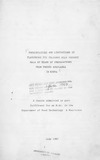| dc.description.abstract | This research was conducted to asses the possibilities and limitations in flavouring of the cultured milk product "mala" by preparations from fruits available in Kenya. Experiments were therefore carried out to: - determine the sucrose and fruit pulp or juice
levels in mala most acceptable to Kenyans and the comparative acceptability of different fruit based flavours; - optimise the viscosity of mala flavoured with fruit juices; devise simple means for preparation and preservation of fruit-sugar mixes for aromatising and
sweetening mala; - assess the storage quality of mala flavoured with selected fruit-sugar mixes.
Samples of the cultured milk product mala flavoured with different fruits at varying fruit
and sugar levels were tested for acceptability by adult Kenyans. Pulps of mango, banana and strawberry, passion fruit juice and pineapple juice together with its pieces were used to flavour mala. For the various fruit-sugar preparations the
optimum flavouring effect was obtained with the following combinations:-
(xii)Mango: 18% pulp and 12% sucrose Passion fruit: 12% juice and 10% sucrose
Banana: 18% pulp and 10% sucrose Strawberry: 20% pulp and 12% sucrose
Pineapple: 16% pieces and juice and 10% sucrose.
When various quality characteristics of mala flavoured with different fruit-sugar combinations at their optimum were compared, mala with mango pulp and with passion fruit juice respectively, had the best appearance; those flavoured with mango and strawberry pulp respectively were the most preferred for taste; mala flavoured with mango pulp had the best consistency. Seeds in strawberry mala were found
objectionable. The same applied to specks and hight viscosity of mala flavoured with banana pulp. The viscosity of mala flavoured with passion fruit juice was considered low. Odour hedonics for all the malas did not differ. When 0.164% pectin and 0.9% gelatine respectively, were added the viscosity of the mala flavoured
with optimum passion fruit juice-sugar mix was improved to that of the control/original mala. Sodium caseinate (17.9% dry matter) added at the rate of 0.6% on dry matter basis to the milk prior to acidification had the same balancing effect.
Raising the temperature of fruit-sugar mixes (xiii) to 75°C, hot filling immediately after removal of bottles from boiling water and cooling to ambient proved adequate to preserve the mixes without refrigeration for one month. Banana pulp without heat
treatment however had to be preserved by freezing.
The possible levels of 330-500 ppm sorbic acid on fruit part, considering that the flavoured mala should not exceed 50 ppm, can protect the product from
infections if not used immediately after opening. Unflavoured mala and mala flavoured with different preparations became unacceptable when yeast and mould counts were of the order of 107/ml. At the same storage temperature unflavoured mala or mala flavoured with different fruit preparations attained these counts after varying storage periods although the initial yeast and mould counts were approximately the same. Unflavoured mala, mala flavoured with pineapple preparation and mala flavoured with banana pulp attained the counts after more than 6 days, 6 days and 4 days storage at 25°C, respectively. The type of fruit preparation added determined the yeast and mould growth and thereby the keeping quality of the product at a given temperatuLe. Sorbic acid at 200 ppm of the final product prolonged the storage period of mala flavoured with passion fruit juice sugar mix from 6 to 8 days at 15°C by slowing down the initial proliferation of yeasts and moulds. Mala flavoured with fruit preparations
other than passion fruit juice showed a decrease of pH and viscosity and an increase of
titrable acidity over the storage period. On the other hand mala flavoured with passion fruit juice showed an increase in pH, a decrease in titrable acidity and a constant viscosity over the storage period. The latter may be due to the hydrocolloids added to improve the viscosity of the product. | en |

